
Banksia sphaerocarpa, commonly known as the fox banksia or round-fruit banksia, is a species of shrub or tree in the plant genus Banksia. It is generally encountered as a 1–2 m (3.3–6.6 ft) high shrub, and is usually smaller in the north of its range. This species has narrow green leaves, and brownish, orange or yellow round flower spikes which may be seen from January to July. It is widely distributed across the southwest of Western Australia, growing exclusively in sandy soils. It is usually the dominant plant in scrubland or low woodland. It is pollinated by, and is a food source for, birds, mammals, and insects.

Acacia penninervis, commonly known as mountain hickory wattle, or blackwood, is a perennial shrub or tree is an Acacia belonging to subgenus Phyllodineae, that is native to eastern Australia.

Tephrosia is a genus of flowering plants in the family Fabaceae. It is widespread in both the Eastern and Western Hemisphere, where it is found in tropical and warm-temperate regions.
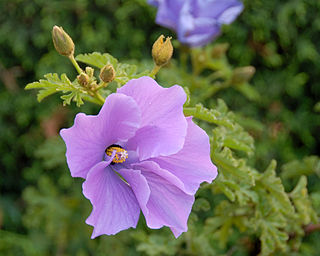
Alyogyne huegelii is a flowering plant found in the Southwest botanical province of Western Australia, extending along its entire coastline. A large-flowered shrub, the species favours the sands of coastal shrublands and heath.

Comesperma is a genus of shrubs, herbs and lianas in the family Polygalaceae. The genus is endemic to Australia. It was defined by the French botanist Jacques Labillardière in his 1806 work Novae Hollandiae Plantarum Specimen. The genus name is derived from the Ancient Greek words come ("hair") and sperma ("seed"), and relates to the seeds bearing tufts of hair. The genus is distributed over southern Australia, particularly in the southwest of Western Australia, where 19 species are found. 24 species have been described.

Utricularia caerulea, the blue bladderwort, is a very small to medium-sized carnivorous plant that belongs to the genus Utricularia. U. caerulea spans a wide native range, including areas in tropical Africa, Asia, and Australia. It grows as a terrestrial plant in wet, shallow soils over rock, in wet grasslands, in swamps, or near streams in open communities, mostly at lower altitudes but ascending to as much as 2,100 m (6,890 ft). It was originally described and published by Carl Linnaeus in 1753.
Banksia gardneri var. gardneri is a variety of Banksia gardneri. As an autonym, it is defined as encompassing the type material of the species. It is native to the Southwest Botanical Province of Western Australia.
Banksia leptophylla var. leptophylla is a variety of Banksia leptophylla. It is native to the Southwest Botanical Province of Western Australia. As an autonym, it is defined as containing the type specimen of the species.
Banksia nutans var. nutans is a variety of the plant Banksia nutans. It is native to the Southwest Botanical Province of Western Australia. As an autonym, its name is defined as containing the type specimen of the species.

Acacia brownii, commonly known as heath wattle, is an erect or spreading shrub which is endemic to eastern Australia.

Drosera menziesii, the pink rainbow, is an erect or scrambling perennial tuberous species in the carnivorous plant genus Drosera. It is endemic to Western Australia and grows in a variety of habitats, including winter-wet depressions, swamps, and granite outcrops in clay or peat sand soils or loam. D. menziesii produces small, circular carnivorous leaves along an undulating erect stem that can be .05–1.1 m (0.2–3.6 ft) high. Its pink flowers emerge from July to November.
Tephrosia clementii is a plant species, endemic to the north-west of Western Australia. It is an annual with a prostrate, spreading habit, growing to between 0.1 and 0.25 metres high. Orange or red flowers are produced between January and March in the species' native range.

Acacia adoxa, commonly known as the grey-whorled wattle, is a species of flowering plant in the family Fabaceae and is endemic to north-western Australia. It is a dense, low-lying shrub with linear, more or less cylindrical phyllodes in whorls of 6 to 10, heads of golden-yellow flowers, and flat, sticky pods.
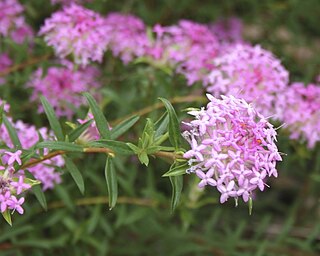
Pimelea rosea, commonly known as rose banjine, is a species of flowering plant in the family Thymelaeaceae and is endemic to the south-west of Western Australia. It is an erect shrub with narrowly elliptic leaves, and clusters of pale pink to reddish-purple flowers surrounded by 4 egg-shaped involucral bracts.

Acacia ramulosa, commonly known as horse mulga or bowgada wattle, is a shrub belonging to the genus Acacia and the subgenus Juliflorae endemic to arid areas of Australia.
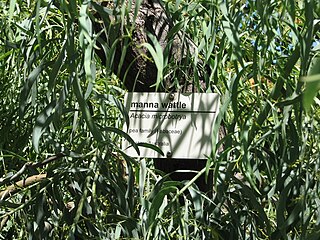
Acacia microbotrya, commonly known as manna wattle or gum wattle, is a shrub or tree belonging to the genus Acacia and the subgenus Phyllodineae that is native to Western Australia.
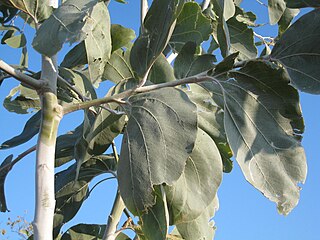
Acacia dunnii, commonly known as elephant ear wattle or Dunn's wattle, is a shrub or tree of the genus Acacia and the subgenus Plurinerves.

Verticordia luteola is a species of flowering plant in the myrtle family Myrtaceae, and is endemic to the south-west of Western Australia. It is a more or less openly branched shrub with crowded leaves on its side branches and spikes of pale yellow or bright pink flowers which turn cream to brownish as they age. This verticordia is a summer-flowering species.

Tephrosia glomeruliflora, or pink tephrosia, is a perennial (non-climbing) herb in the family Fabaceae, endemic to South Africa. It is also found on the eastern coast of Australia, in New South Wales and Queensland, where it is considered an environmental weed.
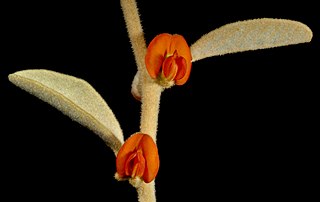
Tephrosia arenicola is a plant in the Fabaceae family, native to the north of Western Australia. The species has no synonyms.
















